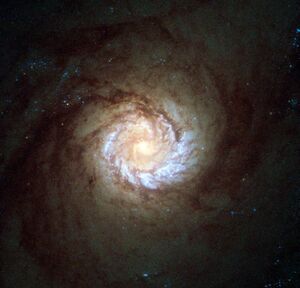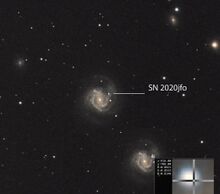Astronomy:Messier 61
| Messier 61[1] | |
|---|---|
 Image taken by Hubble Space Telescope, April 28, 2014[2] Credit: ESA/Hubble & NASA. Acknowledgement: Det58 | |
| Observation data (J2000 epoch) | |
| Constellation | Virgo |
| Right ascension | 12h 21m 54.9s[3] |
| Declination | +04° 28′ 25″[3] |
| Redshift | 0.005224±0.000007[3] |
| Helio radial velocity | 1566±2 km/s[3] |
| Galactocentric velocity | 1483±4 km/s[3] |
| Distance | 52.5 ± 2.3 Mly (16.10 ± 0.71 Mpc) |
| Apparent magnitude (V) | 9.7[4] |
| Characteristics | |
| Type | SAB(rs)bc,[3] HIISy2[3] |
| Apparent size (V) | 6.5 × 5.8 arcmin[3] |
| Other designations | |
| NGC 4303,[3] UGC 07420,[3] PGC 040001,[3] MCG +01-32-022,[3] GC 2878 | |
References: SIMBAD: Search M61 | |
Messier 61 (also known as M61 or NGC 4303) is an intermediate barred spiral galaxy in the Virgo Cluster of galaxies. It was first discovered by Barnaba Oriani on May 5, 1779, six days before Charles Messier discovered the same galaxy. Messier had observed it on the same night as Oriani but had mistaken it for a comet.[5] Its distance has been estimated to be 45.61 million light years from the Milky Way Galaxy. It is a member of the M61 Group of galaxies, which is a member of the Virgo II Groups, a series of galaxies and galaxy clusters strung out from the southern edge of the Virgo Supercluster.[6]
Properties
M61 is one of the largest members of Virgo Cluster, and belongs to a smaller subgroup known as the S Cloud.[7][8] The morphological classification of SAB(rs)bc[3] indicates a weakly-barred spiral (SAB) with the suggestion of a ring structure (rs) and moderate to loosely wound spiral arms.[9] It has an active galactic nucleus[10] and is classified as a starburst galaxy containing a massive nuclear star cluster with an estimated mass of 105 solar masses and an age of 4 million years,[11] It cohabits with an older massive star cluster as well as a likely older starburst.[11] Evidence of significant star formation and active bright nebulae appears across M61's disk.[12] Unlike most late-type spiral galaxies within the Virgo Cluster, M61 shows an unusual abundance of neutral hydrogen (H I).[13]
Extragalactic supernovae
Eight extragalactic supernovae have so far been observed in M61, making it one of the most prodigious galaxies for such cataclysmic events.[14][15][5] These include: SN 1926A (type II-K, mag. 14),[15] SN 1961I (Type II, mag. 13),[15] SN 1964F (Type II, mag. 14),[16] SN 1999gn (Type II, mag. 16),[17] SN 2006ov (Type II, mag. 14.9),[18] SN 2008in (Type II, mag. 14.9),[19] SN 2014dt (type Ia-pec, mag. 13.6),[20] and SN 2020jfo (Type II, mag. 16).[21][22]
Gallery
Spiral galaxy Messier 61 is aligned face-on towards Earth.[23]
See also
References
- ↑ Tschöke, D.; Hensler, G.; Junkes, N. (2000). "X-rays from the barred galaxy NGC 4303". Astronomy and Astrophysics 360 (2): 447–456. Bibcode: 2000A&A...360..447T.
- ↑ "A hungry starburst galaxy". ESA/Hubble Picture of the Week. http://www.spacetelescope.org/images/potw1417a/.
- ↑ 3.00 3.01 3.02 3.03 3.04 3.05 3.06 3.07 3.08 3.09 3.10 3.11 3.12 "NASA/IPAC Extragalactic Database". Results for M 61. http://ned.ipac.caltech.edu/cgi-bin/objsearch?objname=Messier+61&extend=no&hconst=73&omegam=0.27&omegav=0.73&corr_z=1&out_csys=Equatorial&out_equinox=J2000.0&obj_sort=RA+or+Longitude&of=pre_text&zv_breaker=30000.0&list_limit=5&img_stamp=YES.
- ↑ "Messier 61". https://messier.seds.org/m/m061.html.
- ↑ 5.0 5.1 "Messier 61". http://messier.seds.org/m/m061.html/.
- ↑ "The Virgo III Groups". Atlas of the Universe. http://www.atlasoftheuniverse.com/galgrps/viriii.html.
- ↑ "Galaxy On Line Database Milano Network (GOLDMine)". http://goldmine.mib.infn.it/.
- ↑ "The Virgo Cluster". http://www.atlasoftheuniverse.com/galgrps/vir.html.
- ↑ de Vaucouleurs, Gérard (April 1963). "Revised Classification of 1500 Bright Galaxies". Astrophysical Journal Supplement 8: 31. doi:10.1086/190084. Bibcode: 1963ApJS....8...31D.
- ↑ Jiménez-Bailón, E.; Santos-Lleó, M.; Mas-Hesse, J. M.; Guainazzi, M.; Colina, L.; Cerviño, M.; González Delgado, Rosa M. (2003). "Nuclear Activity and Massive Star Formation in the Low-Luminosity Active Galactic Nucleus NGC 4303: Chandra X-Ray Observations". The Astrophysical Journal 593 (1): 127–141. doi:10.1086/376554. Bibcode: 2003ApJ...593..127J.
- ↑ 11.0 11.1 Colina, L.; Gonzalez Delgado, R.; Mas-Hesse, J. Miguel; Leitherer, C.; Jimenez Bailon, E. (2007). "Supermassive black holes in the Sbc spiral galaxies NGC 3310, NGC 4303 and NGC 4258". Astronomy and Astrophysics 469 (2): 405–423. doi:10.1051/0004-6361:20066784. Bibcode: 2007A&A...469..405P.
- ↑ Koopmann, R.; Kenney, J. D. P. (2004). "Hα Morphologies and Environmental Effects in Virgo Cluster Spiral Galaxies". The Astrophysical Journal 613 (2): 866–885. doi:10.1086/423191. Bibcode: 2004ApJ...613..866K.
- ↑ Kenney, J. D.; Young, J. S. (1986). "CO in H I-deficient Virgo cluster spiral galaxies". The Astrophysical Journal Letters 301: L13–L17. doi:10.1086/184614. Bibcode: 1986ApJ...301L..13K.
- ↑ Supernovae which have been observed in Messier catalog galaxies
- ↑ 15.0 15.1 15.2 "List of Supernovae". Central Bureau for Astronomical Telegrams. http://www.cbat.eps.harvard.edu/lists/Supernovae.html.
- ↑ Transient Name Server entry for SN 1964F. Retrieved 21 June 2023.
- ↑ Transient Name Server entry for SN 1999gn. Retrieved 21 June 2023.
- ↑ Transient Name Server entry for SN 2006ov. Retrieved 21 June 2023.
- ↑ Transient Name Server entry for SN 2008in. Retrieved 21 June 2023.
- ↑ Transient Name Server entry for SN 2014dt. Retrieved 21 June 2023.
- ↑ "SN 2020jfo". Transient Name Server. IAU. https://www.wis-tns.org/object/2020jfo.
- ↑ Boffi, F.R.; Sparks, W.B.; Macchetto, F.D. (1999). "A search for candidate light echoes: Photometry of supernova environments". Astronomy and Astrophysics Supplement Series 138 (2): 253–266. doi:10.1051/aas:1999274. Bibcode: 1999A&AS..138..253B.
- ↑ "A portrait of a beauty" (in en). https://www.eso.org/public/images/potw1901a/.
External links
- messier.seds.org/m/m061.html
- Messier 61 on WikiSky: DSS2, SDSS, GALEX, IRAS, Hydrogen α, X-Ray, Astrophoto, Sky Map, Articles and images
Coordinates: ![]() 12h 21m 54.9s, +04° 28′ 25″
12h 21m 54.9s, +04° 28′ 25″
 |






